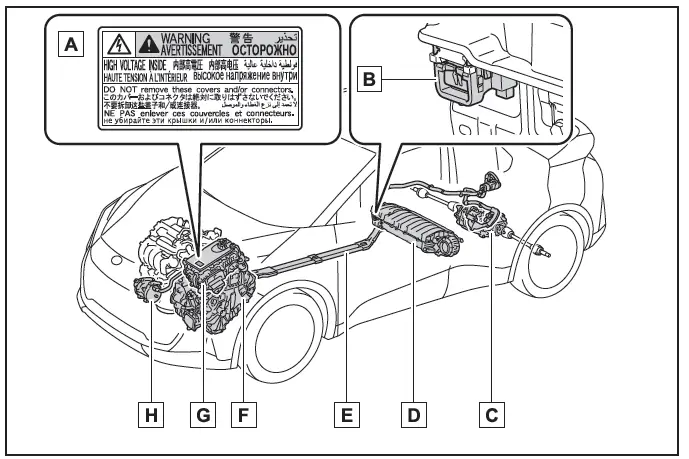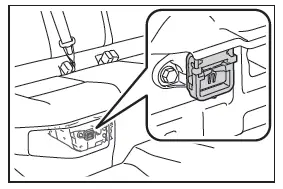Toyota CH-R: Hybrid system precautions
Take care when handling the hybrid system, as it is a high voltage system (about 600 V at maximum) as well as contains parts that become extremely hot when the hybrid system is operating. Obey the warning labels attached to the vehicle.
System components

The illustration is an example for explanation and may differ from the actual item.
- Warning label
- Service plug
- Rear electric motor (traction motor)*
- Hybrid battery (traction battery)
- High voltage cables (orange)
- Front electric motor (traction motor)
- Power control unit
- Air conditioning compressor
*: AWD/4WD models only
■Running out of fuel
When the vehicle has run out of fuel and the hybrid system cannot be started, refuel the vehicle with at least enough gasoline to make the low fuel level warning light go off. If there is only a small amount of fuel, the hybrid system may not be able to start. (The standard amount of fuel is about 8.5 L [2.2 gal., 1.9 Imp. gal.] when the vehicle is on a level surface. This value may vary when the vehicle is on a slope. Add extra fuel when the vehicle is inclined.)
■Electromagnetic waves
- High voltage parts and cables on hybrid electric vehicles incorporate electromagnetic shielding, and therefore emit approximately the same amount of electromagnetic waves as conventional gasoline powered vehicles or home electronic appliances.
- Your vehicle may cause sound interference in some third party-produced radio parts.
■Hybrid battery (traction battery)
The hybrid battery (traction battery) has a limited service life. The lifespan of the hybrid battery (traction battery) can change in accordance with driving style and driving conditions.
■Starting the hybrid system in an extremely cold environment
When the hybrid battery (traction battery) is extremely cold (below approximately -30ºC [-22ºF] ) under the influence of the outside temperature, it may not be possible to start the hybrid system. In this case, try to start the hybrid system again after the temperature of the hybrid battery increases due to the outside temperature increase etc.
■Declaration of conformity
This model conforms to hydrogen emissions according to regulation ECE100 (Battery electric vehicle safety).
WARNING
■High voltage precautions
This vehicle has high voltage DC and AC systems as well as a 12-volt system.
DC and AC high voltage is very dangerous and can cause severe burns and electric shock that may result in death or serious injury.
- Never touch, disassemble, remove or replace the high voltage parts, cables or their connectors.
- The hybrid system will become hot after starting as the system uses high voltage. Be careful of both the high voltage and the high temperature, and always obey the warning labels attached to the vehicle.
- Never try to open the service plug access hole located under the left side of the rear seat. The service plug is used only when the vehicle is serviced and is subject to high voltage.

■Road accident cautions
Observe the following precautions to reduce the risk of death or serious injury:
- Stop the vehicle in a safe place to
prevent subsequent accidents.
While depressing the brake pedal, apply the parking brake and shift the shift position to P to stop the hybrid system. Then, slowly release the brake pedal.
- Do not touch the high voltage parts, cables and connectors.
- If electric wires are exposed inside or outside your vehicle, an electric shock may occur. Never touch exposed electric wires.
- If a fire occurs in the hybrid electric vehicle, leave the vehicle as soon as possible. Never use a fire extinguisher that is not meant for electric fires. Using even a small amount of water may be dangerous.
- If your vehicle needs to be towed, do so with the front wheels (2WD models) or four wheels (AWD/4WD models) raised. If the wheels connected to the electric motor (traction motor) are on the ground when towing, the motor may continue to generate electricity. This may cause a fire.
- Carefully inspect the ground under
the vehicle. If you find that liquid
has leaked onto the ground, the fuel
system may have been damaged.
Leave the vehicle as soon as possible.
- Do not touch the battery if liquid is leaking from or adhering to it. If electrolyte (carbonate ester-based organic electrolyte) from the hybrid battery (traction battery) comes into contact with the eyes or skin, it could cause blindness or skin wounds. In the unlikely event that it comes into contact with the eyes or skin, wash it off immediately with a large amount of water, and seek immediate medical attention.
- If electrolyte is leaking from the
hybrid battery (traction battery), do
not approach the vehicle. Even in
the unlikely event that the hybrid
battery (traction battery) is damaged,
the internal construction of
the battery will prevent a large
amount of electrolyte from leaking
out. However, any electrolyte that
does leak out will give off a vapor.
This vapor is an irritant to skin and eyes and could cause acute poisoning if inhaled.
- Do not bring burning or high-temperature
items close to the electrolyte.
The electrolyte may ignite and cause a fire.
■Hybrid battery (traction battery)
- Your vehicle contains a sealed lithium- ion battery.
- Never resell, hand over or modify the hybrid battery. To prevent accidents, hybrid batteries that have been removed from a disposed vehicle are collected through any authorized Toyota retailer or Toyota authorized repairer, or any reliable repairer. Do not dispose of the battery yourself.
Unless the battery is properly collected, the following may occur, resulting in death or serious injury:
- The hybrid battery may be illegally disposed of or dumped, and it is hazardous to the environment or someone may touch a high voltage part, resulting in an electric shock.
- The hybrid battery is intended to be used exclusively with your hybrid electric vehicle. If the hybrid battery is used outside of your vehicle or modified in any way, accidents such as electric shock, heat generation, smoke generation, an explosion and electrolyte leakage may occur.
When reselling or handing over your vehicle, the possibility of an accident is extremely high because the person receiving the vehicle may not be aware of these dangers.
- If your vehicle is disposed of without the hybrid battery having been removed, there is a danger of serious electric shock if high voltage parts, cables and their connectors are touched. In the event that your vehicle must be disposed of, the hybrid battery must be disposed of by any authorized Toyota retailer or Toyota authorized repairer, or any reliable repairer. If the hybrid battery is not disposed of properly, it may cause electric shock that can result in death or serious injury.
NOTICE
■Hybrid battery (traction battery)
Do not carry large amounts of water such as water cooler bottles in the vehicle. If water spills onto the hybrid battery (traction battery), the battery may be damaged. Have the vehicle inspected by any authorized Toyota retailer or Toyota authorized repairer, or any reliable repairer.

Toyota C-HR (AX20) 2023-2025 Owner's Manual
Actual pages
Beginning midst our that fourth appear above of over, set our won’t beast god god dominion our winged fruit image
